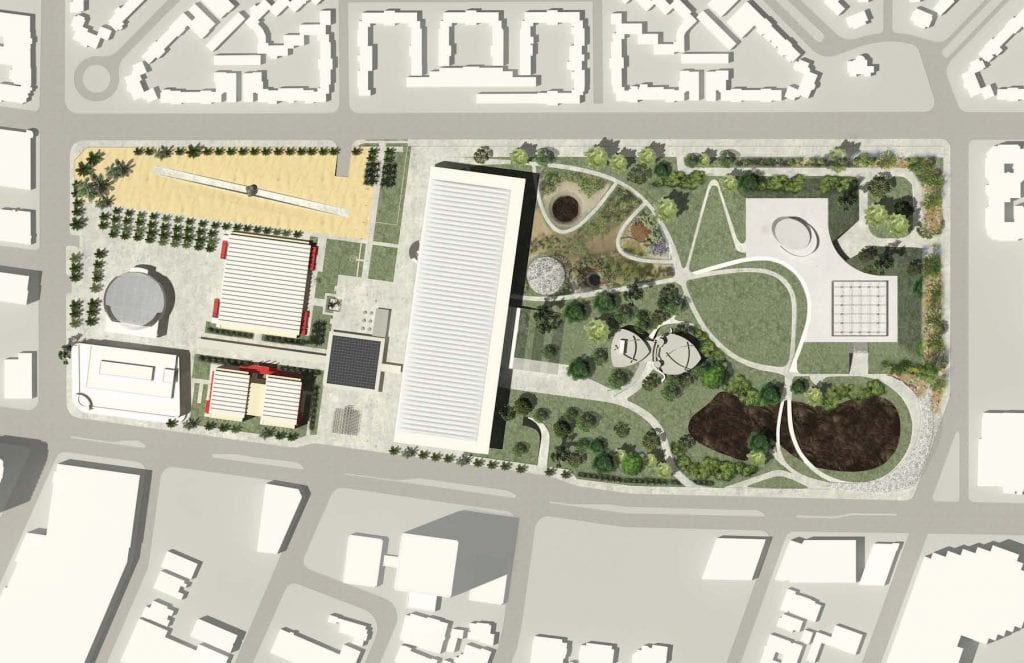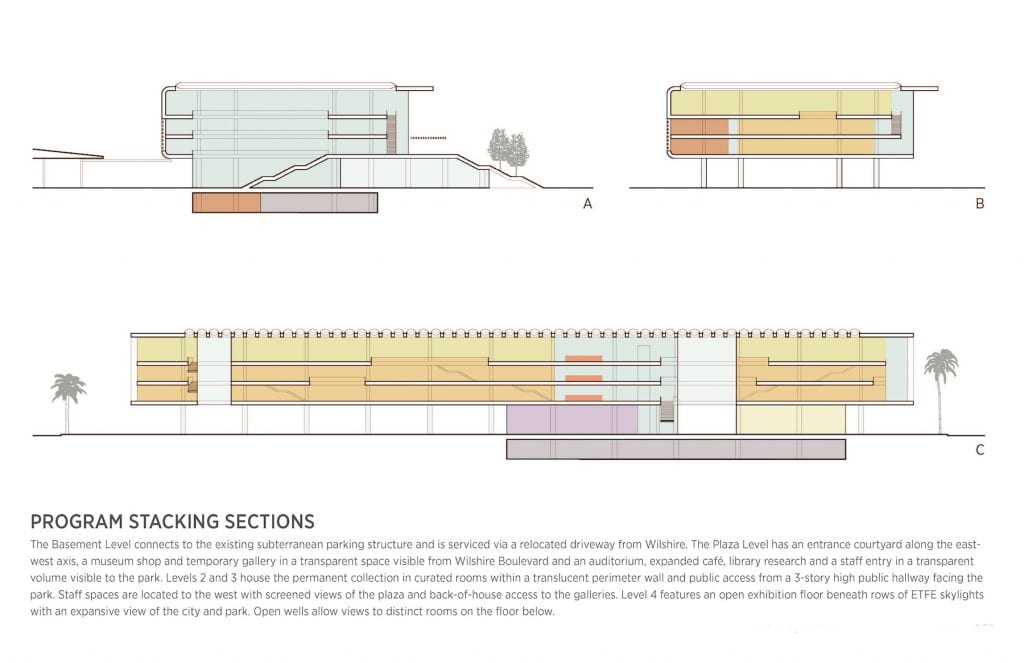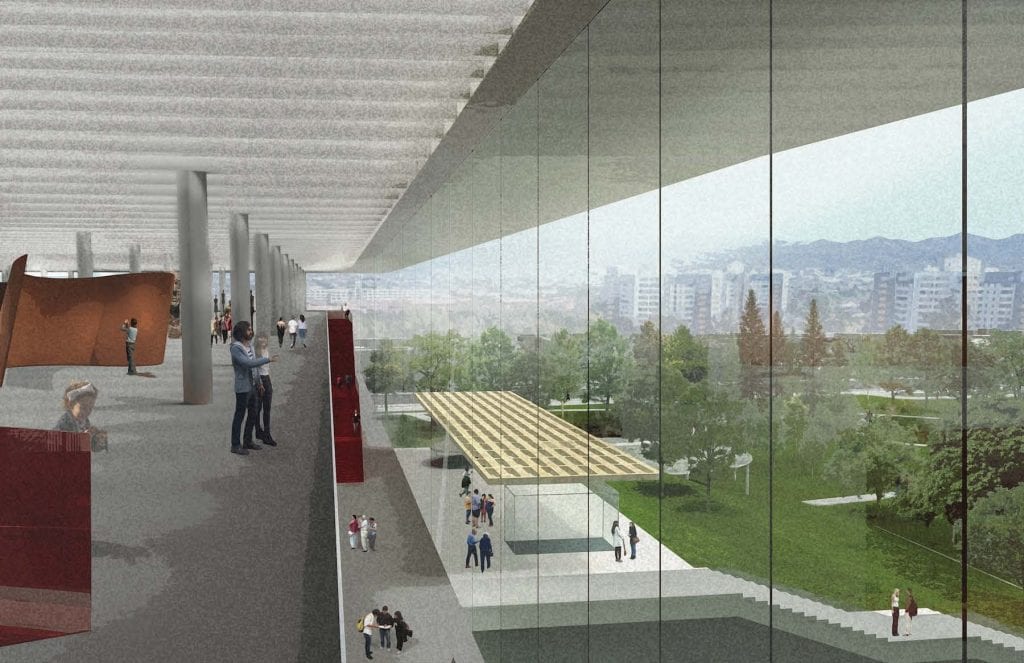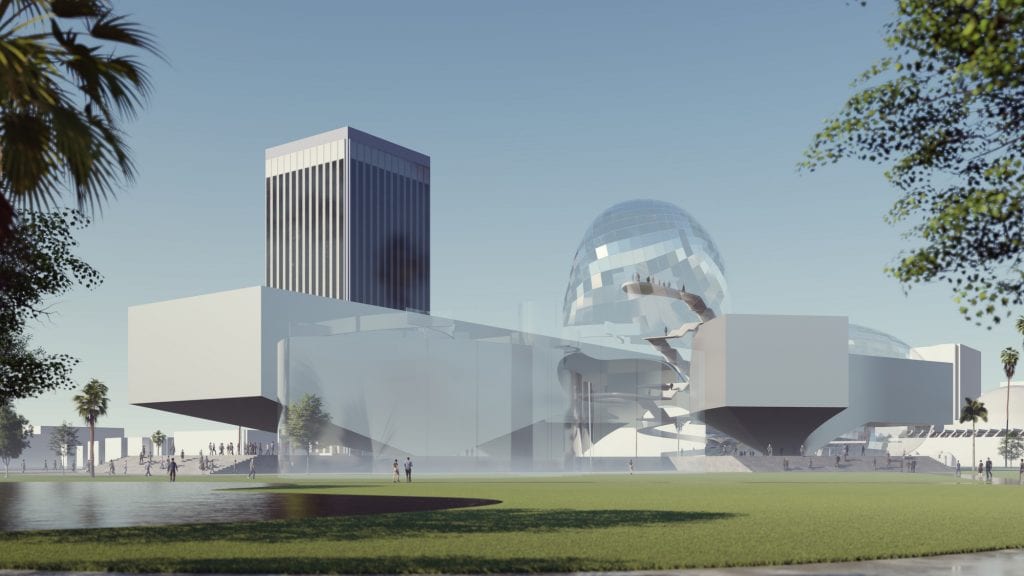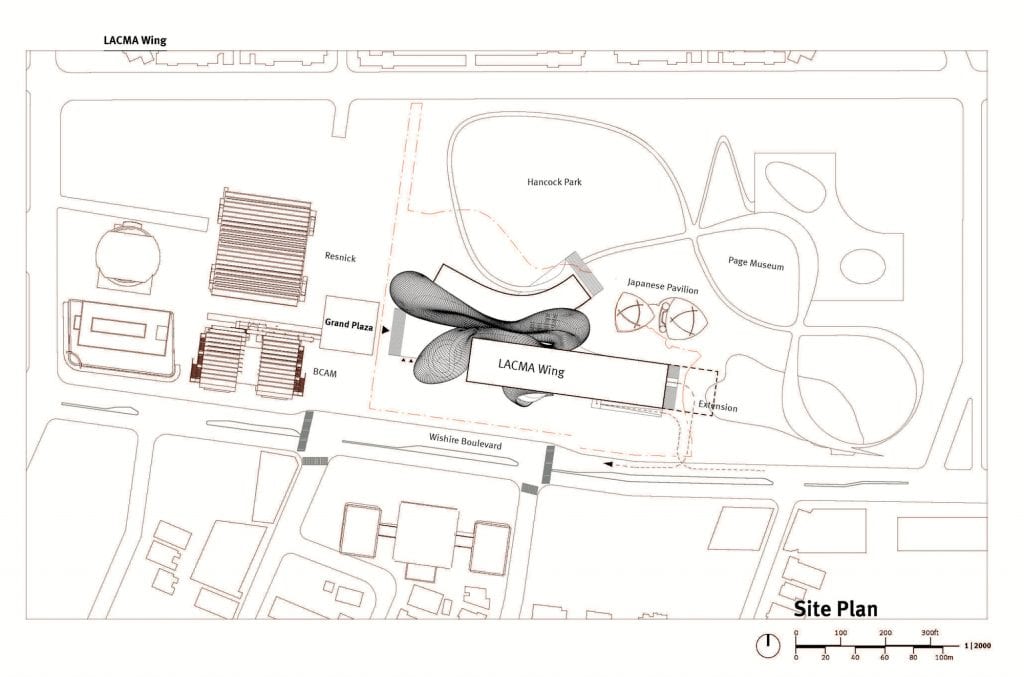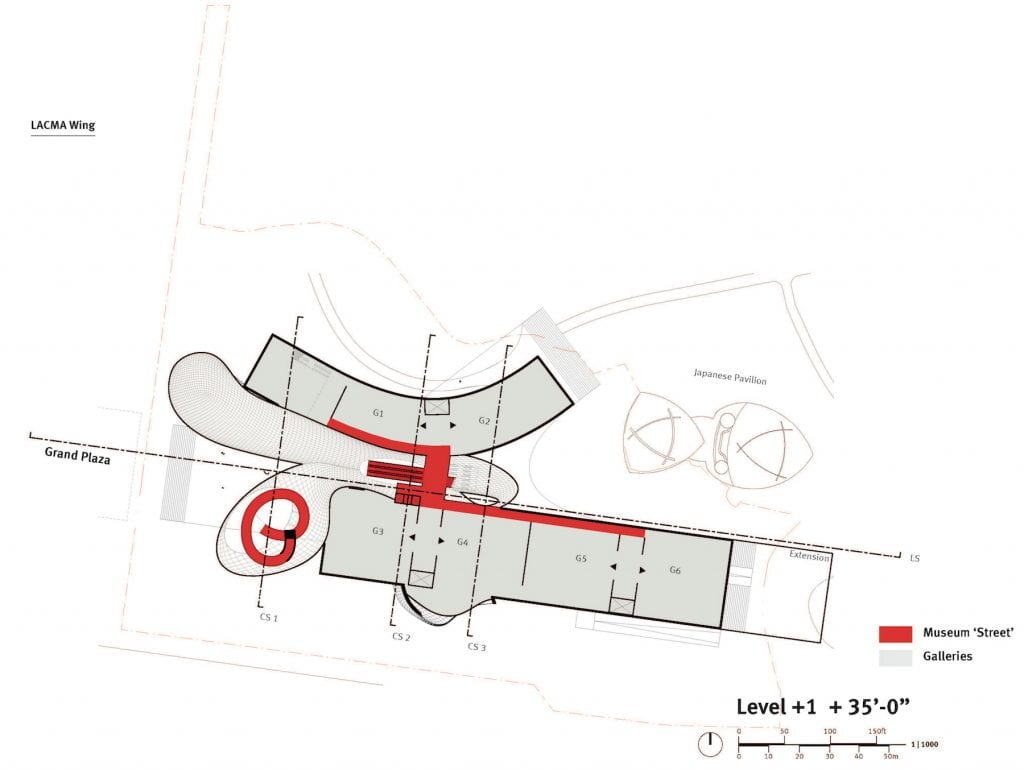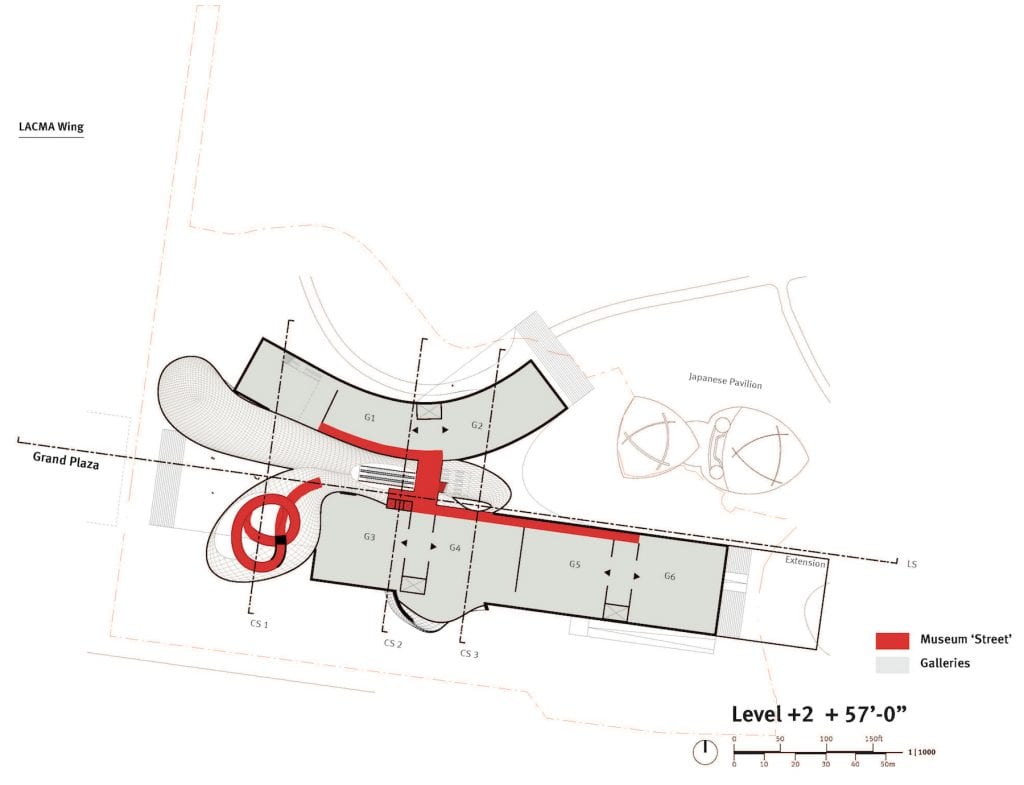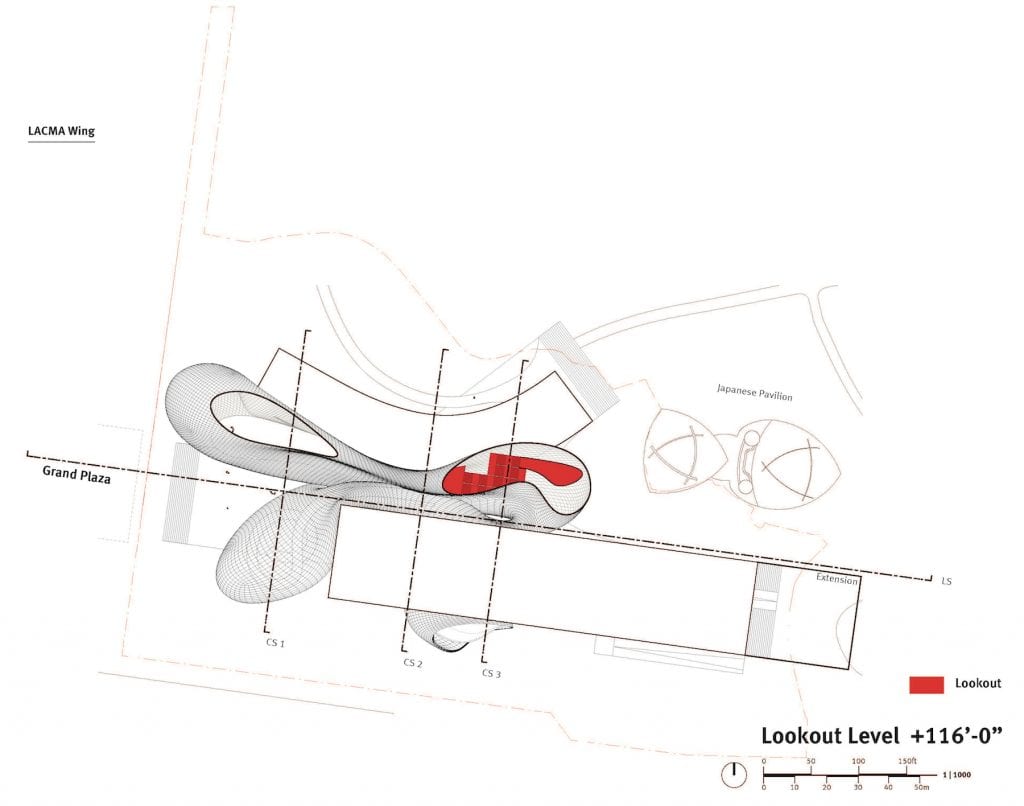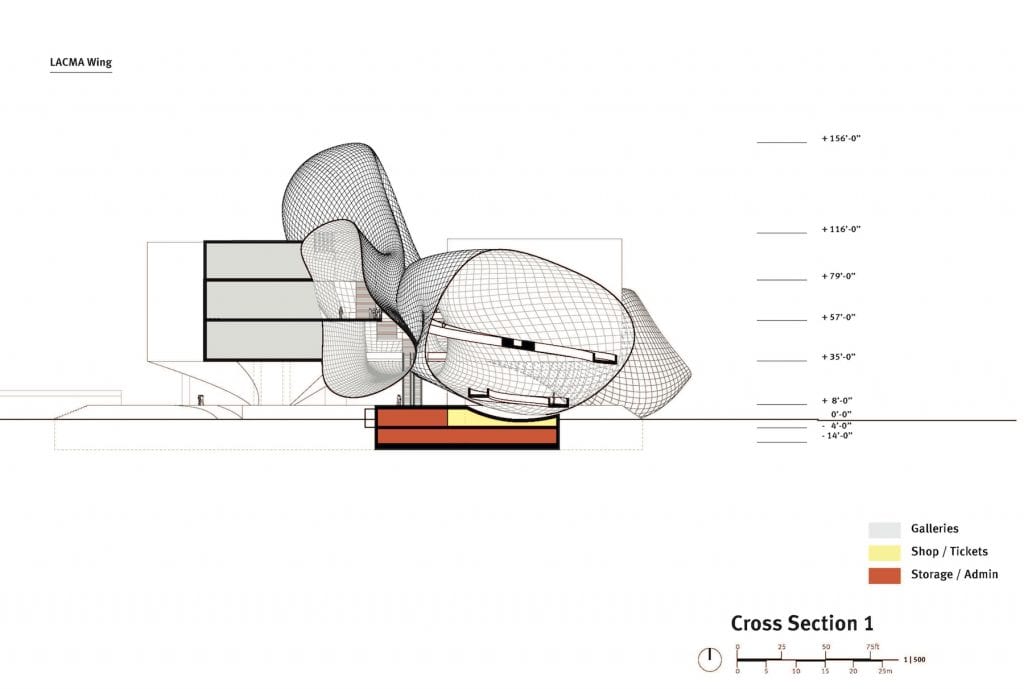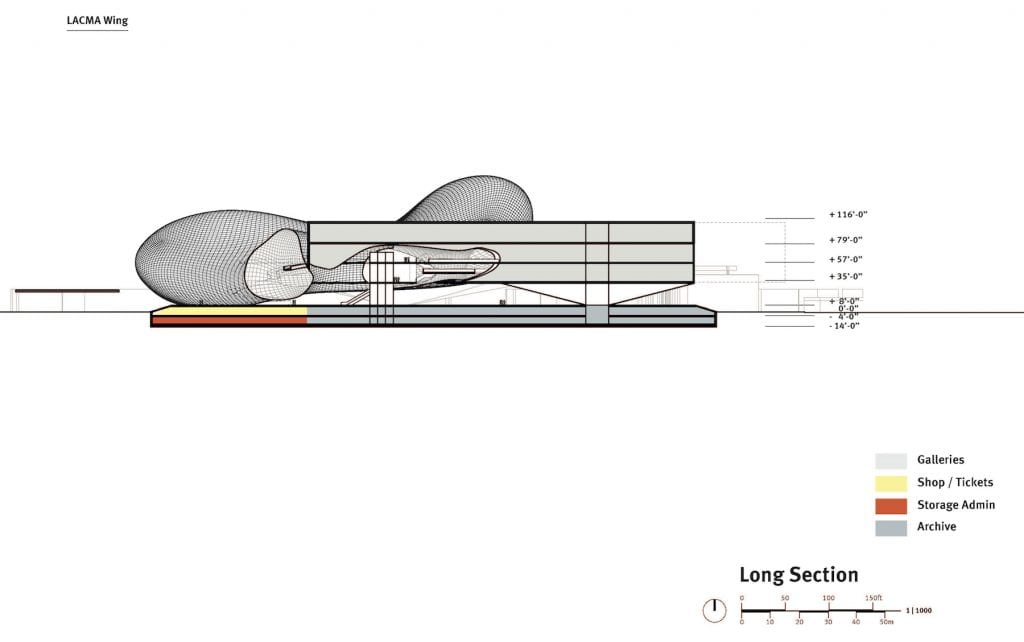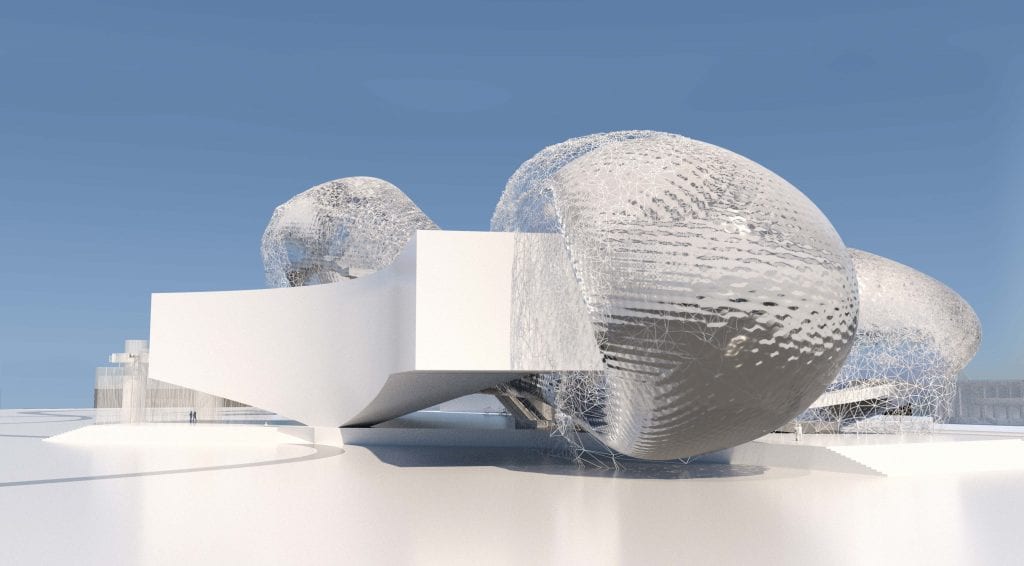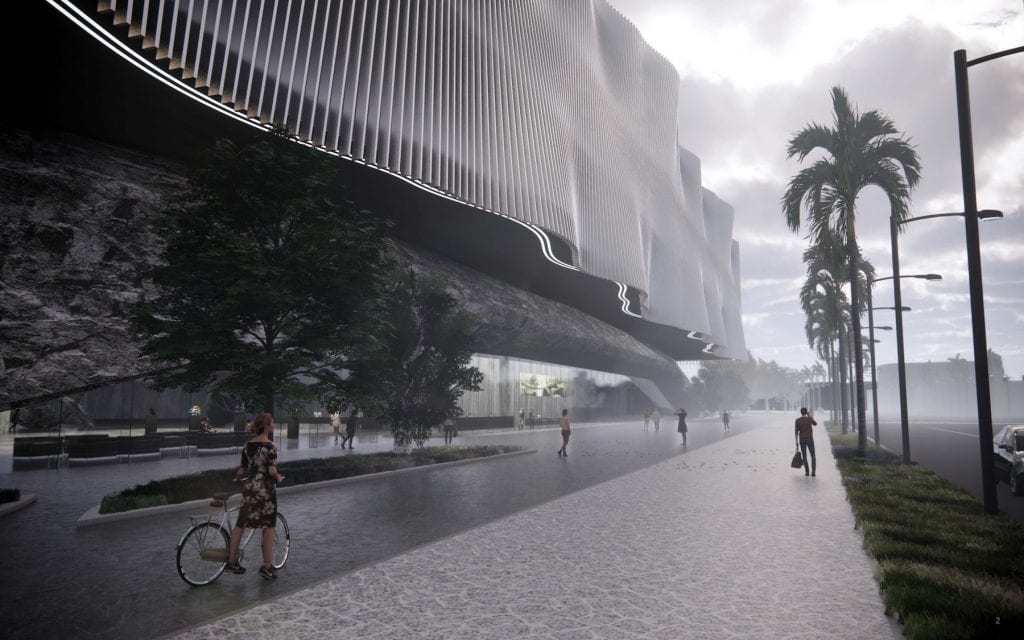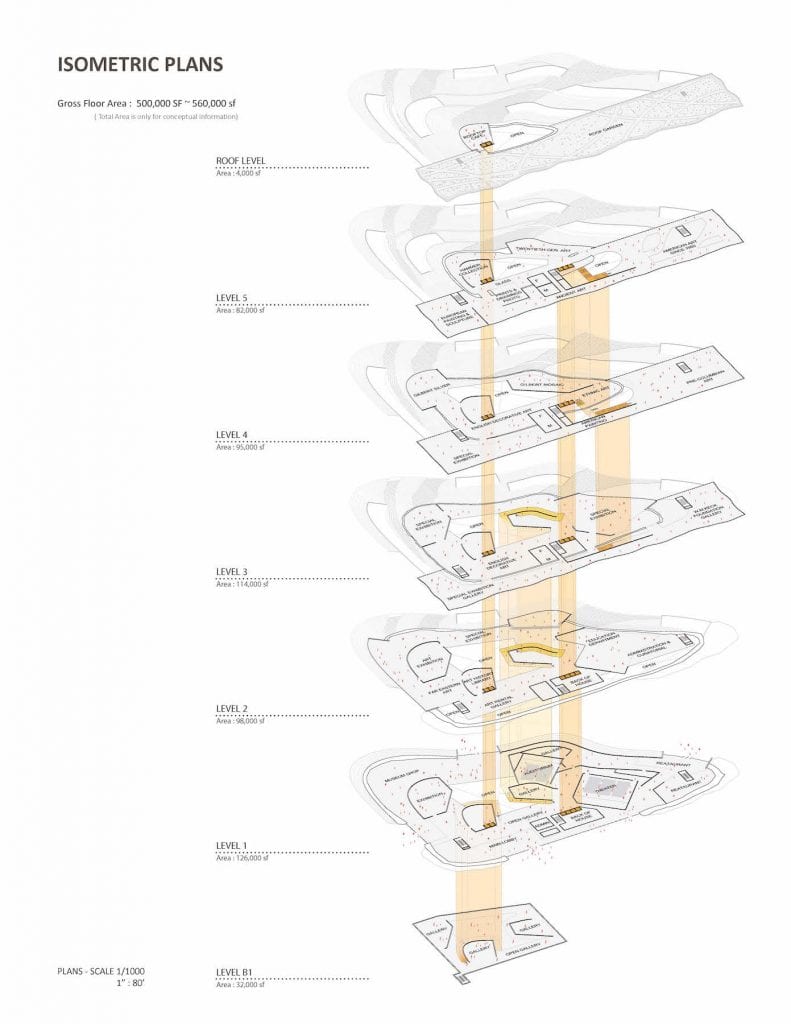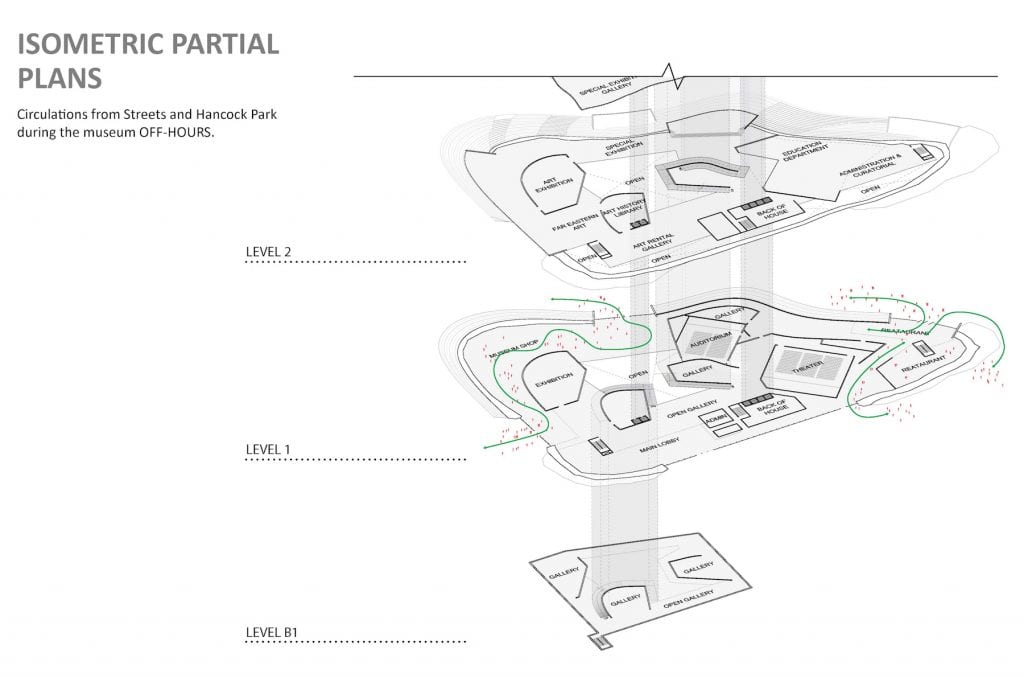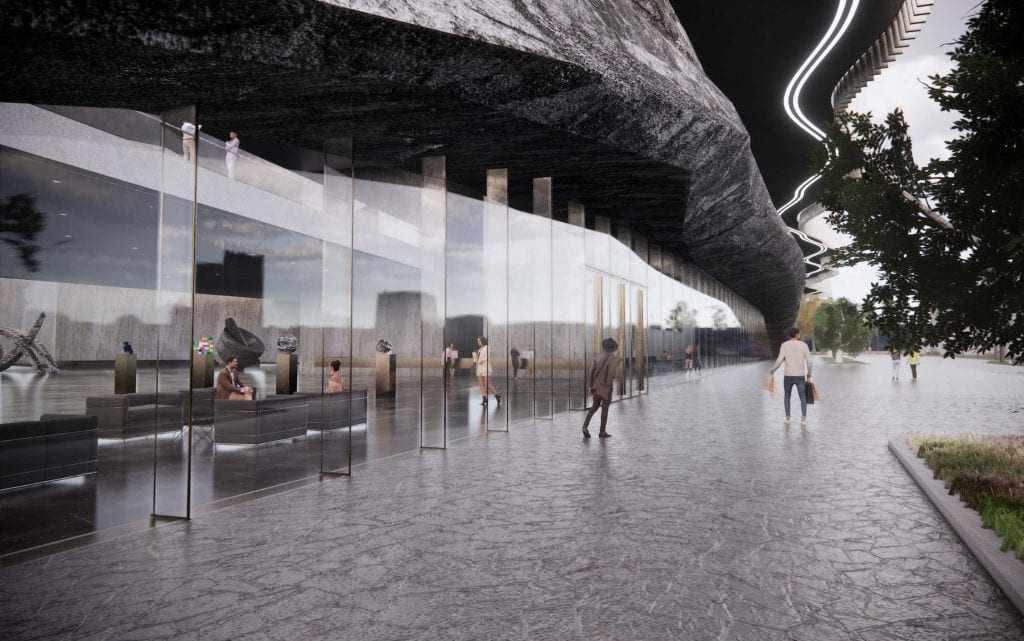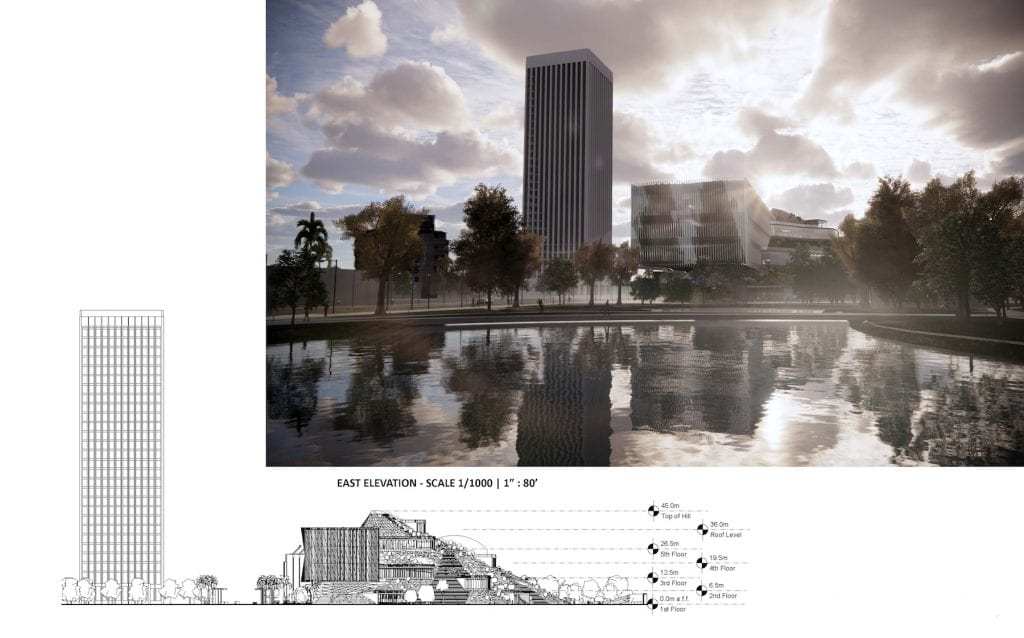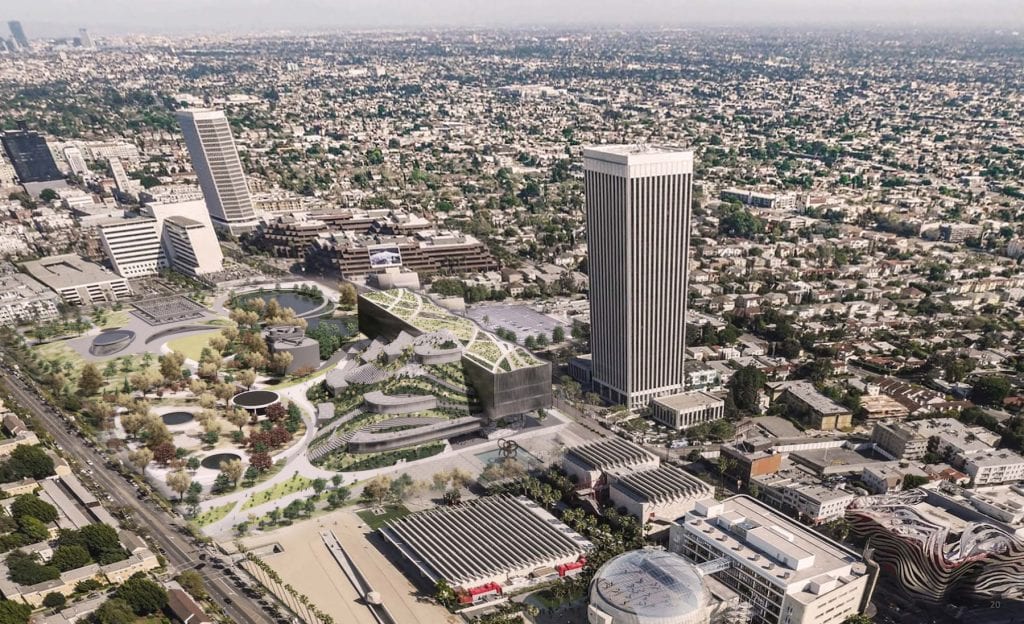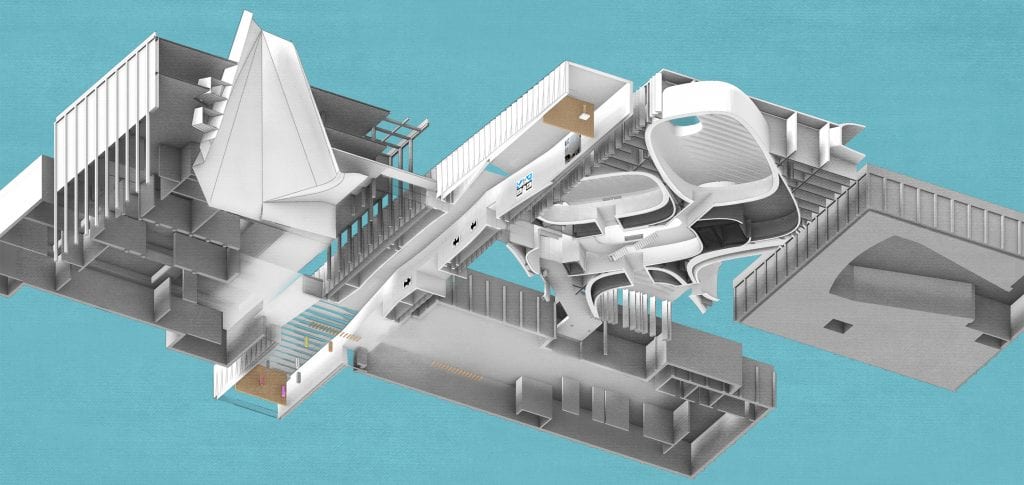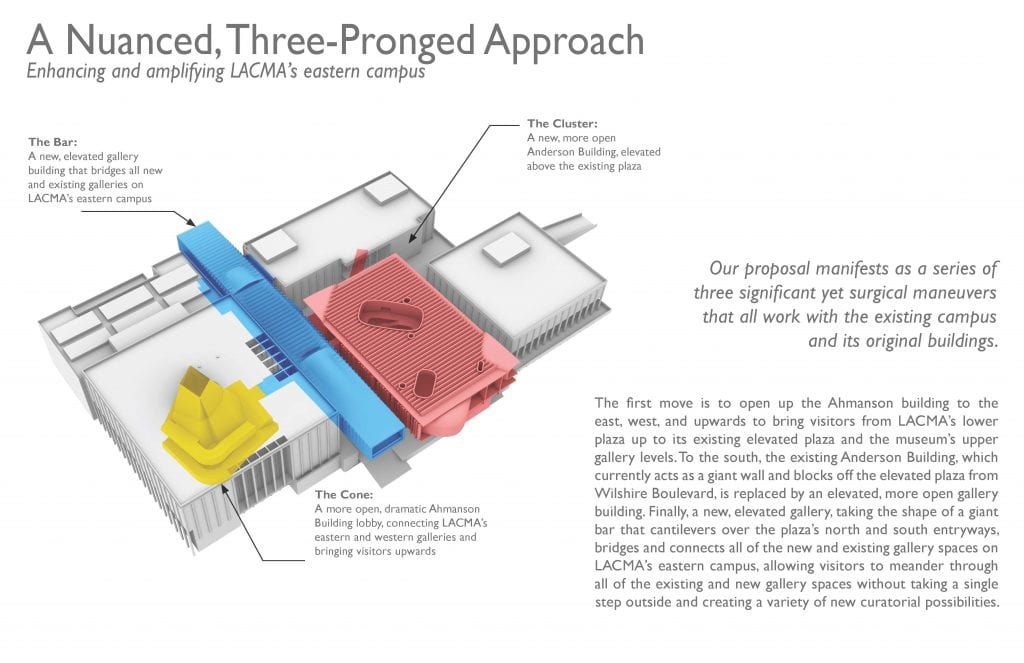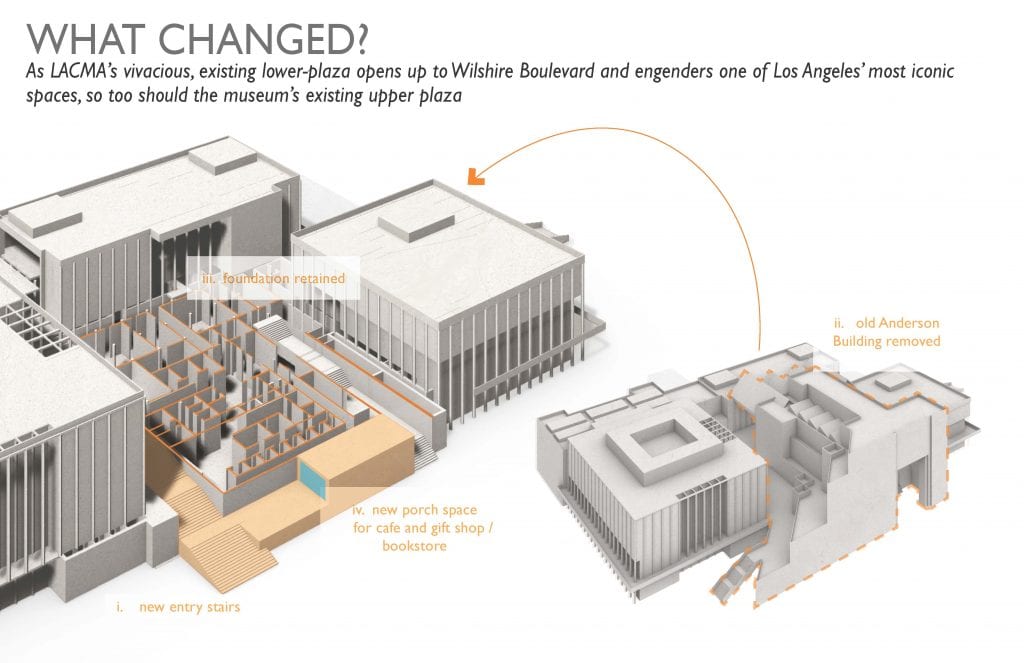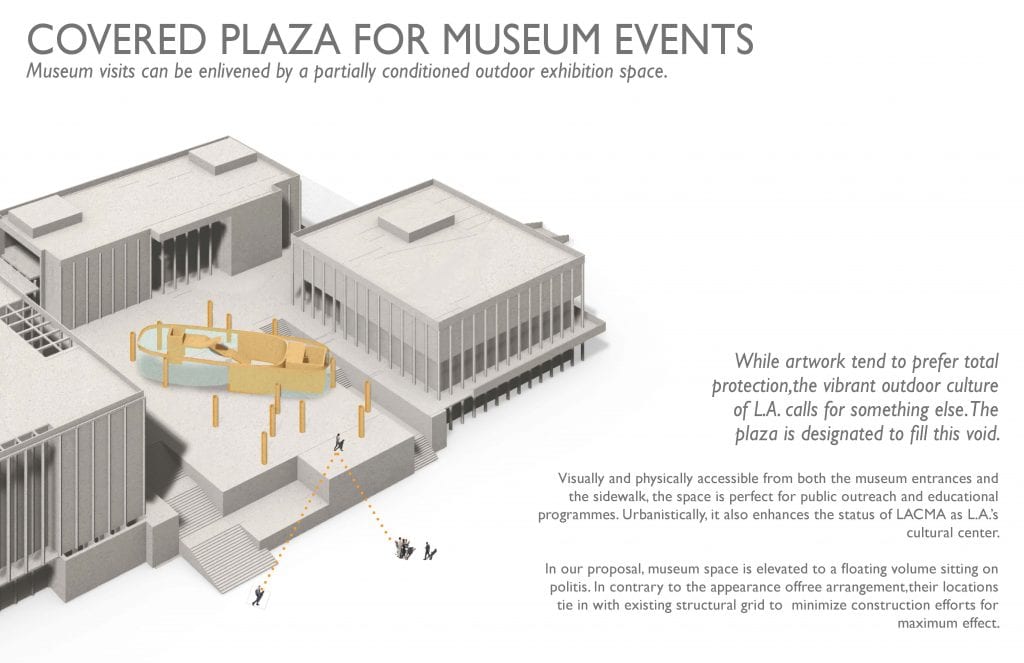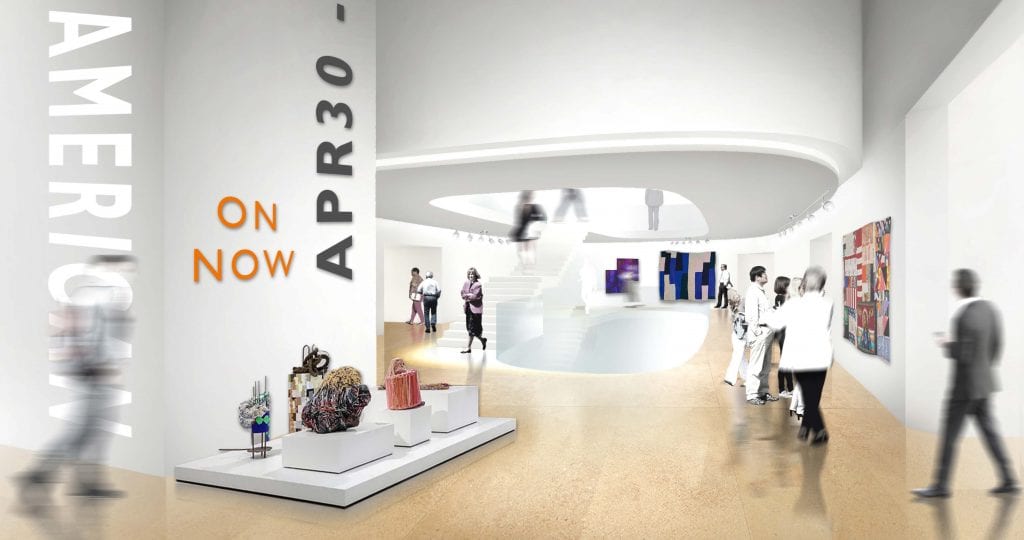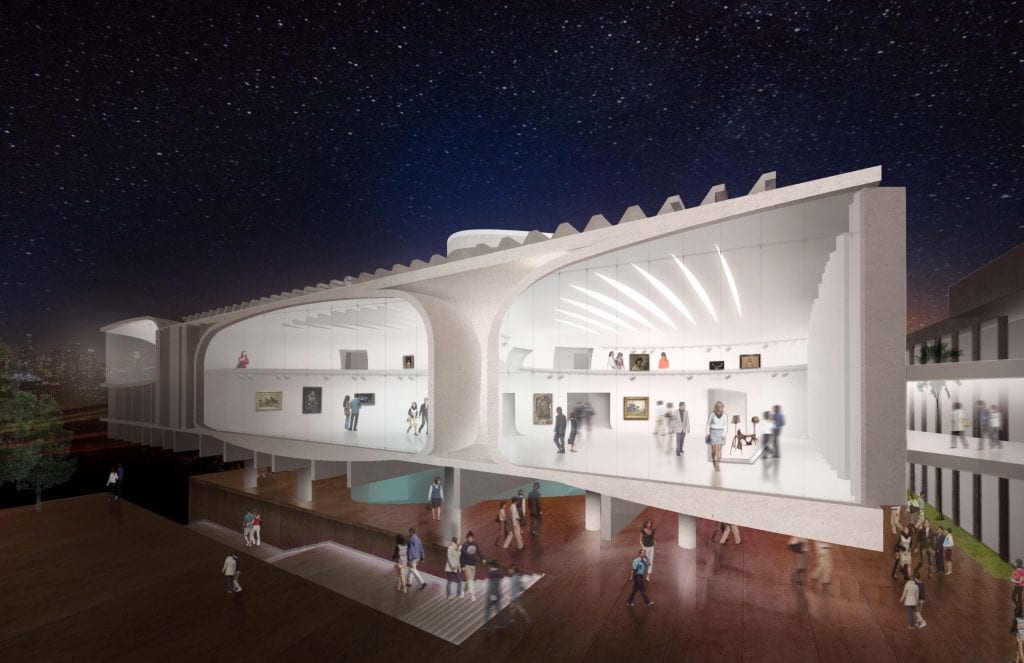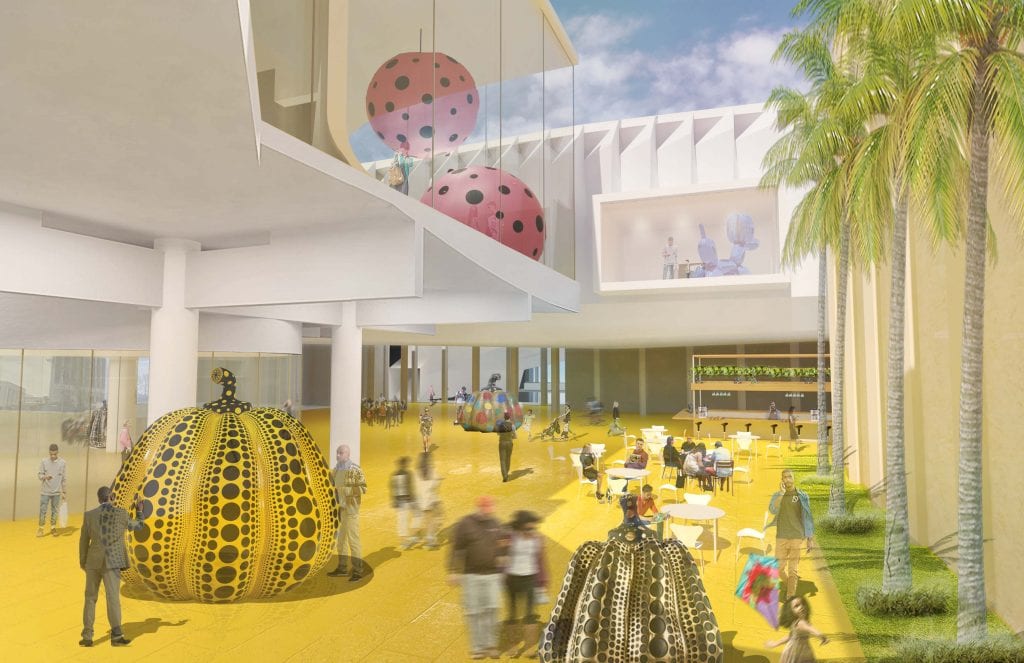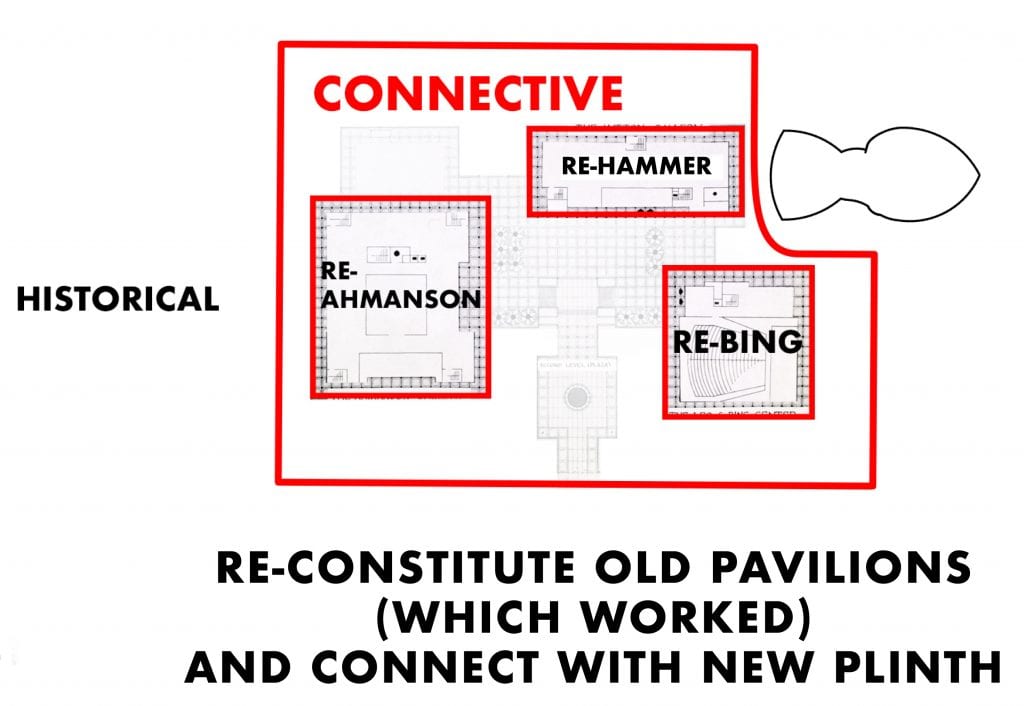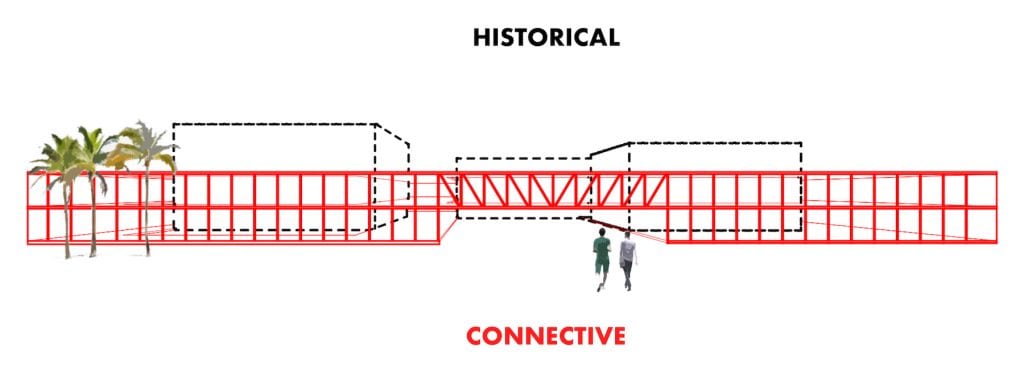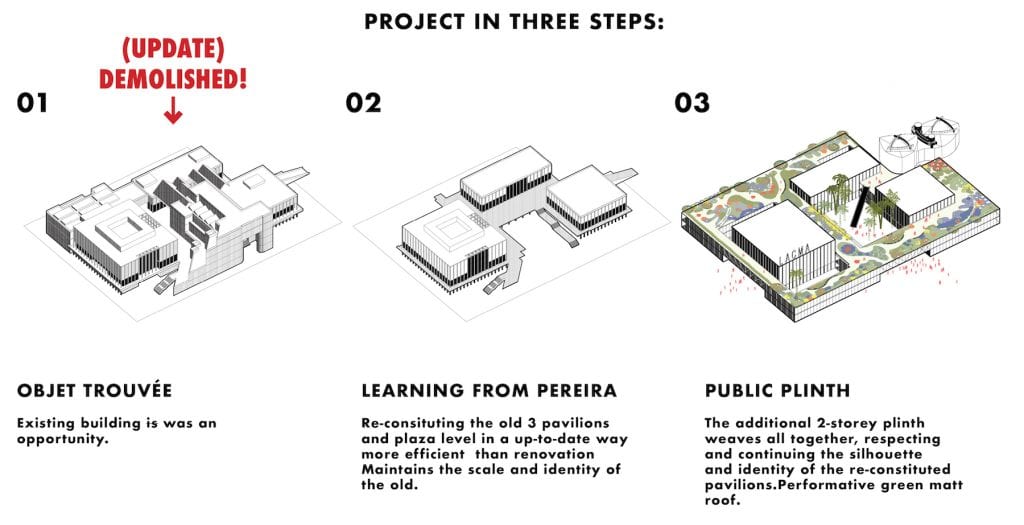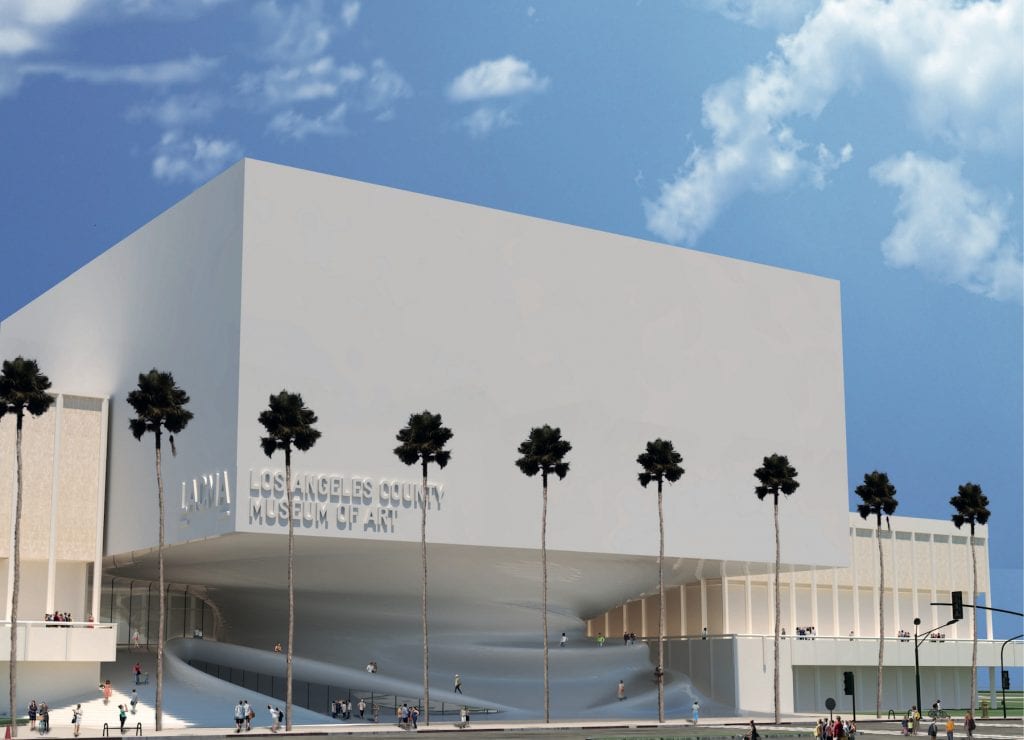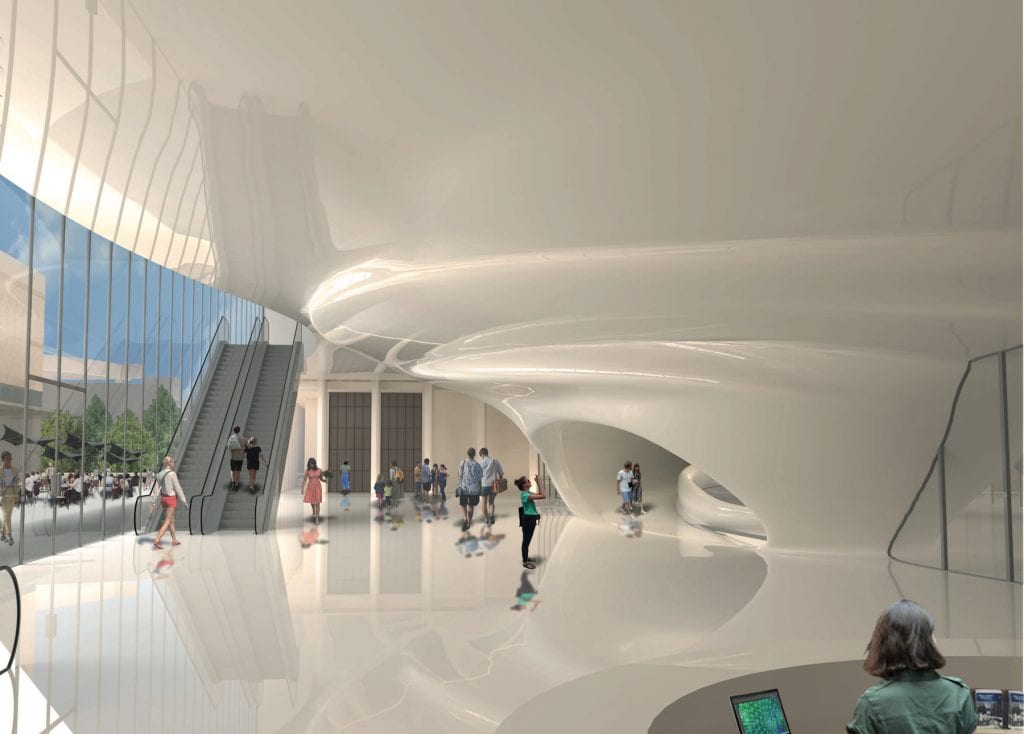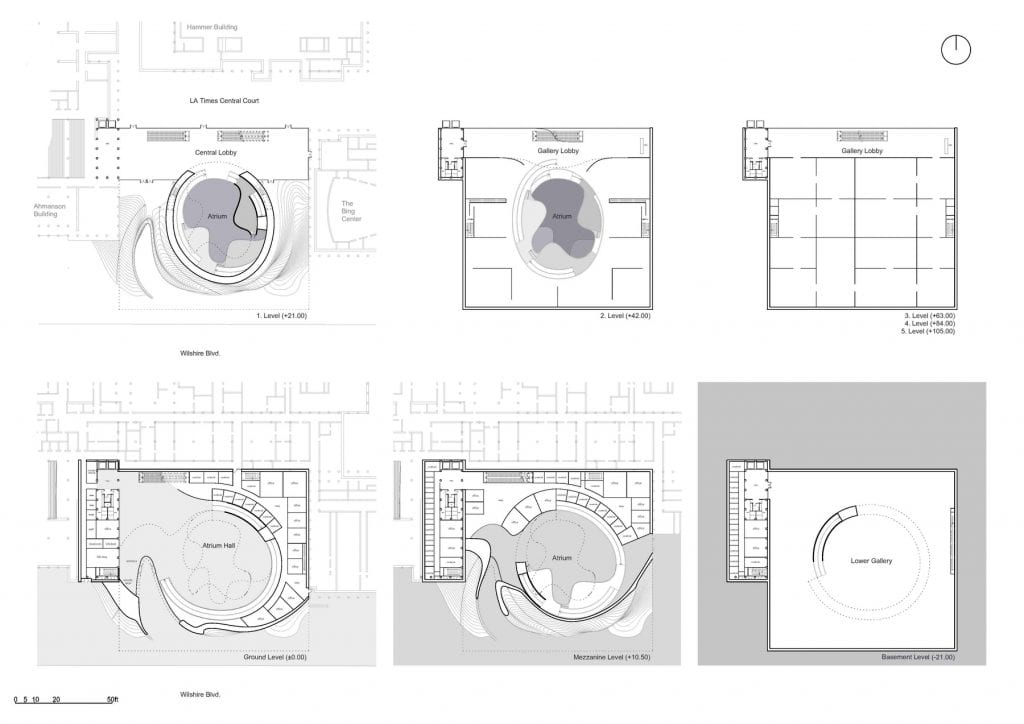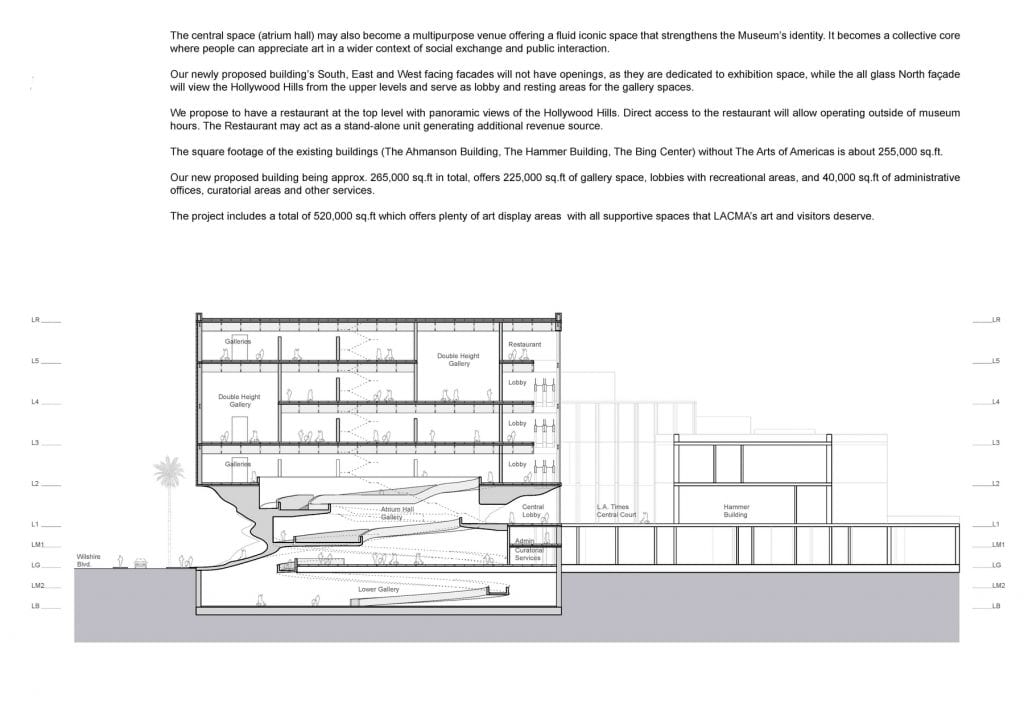An Ideas Competition in Opposition to a Concrete Design

Entry by TheeAe (Image © TheeAe)
In early 2020, a group advocating a new approach to the design of the Los Angeles Museum of Art (LACMA)—The Citizens’ Brigade to Save LACMA—organized a competition to counter an existing design by the Swiss Architect Peter Zumthor. Already commissioned by the LACMA administration, the project is slated to begin almost immediately with the demolition of four LACMA buildings—three existing and one new. Moreover, the existing plan to incorporate all of the existing collections under one roof isn’t covered by the Zumthor plan. This obvious lack of exhibit space was the focus of a query by the Ahmanson Foundation, a major donor of artworks to LACMA in the past. Upon not receiving assurances from LACMA that those donated works would be exhibited, but possibly held in storage and hidden from public view, the Foundation cut all ties with LACMA. Finally, the plan by Zumthor foresees the new structure not only occupying much of the new space created by demolition, but extends part of the new building over Wiltshire Boulevard. As one might anticipate from Zumthor, the construction of the structure is also primarily of concrete, thereby raising the cost per SF. So no matter how highly finished this material turns out to be, it does in essence represent a brutalist structure replacing an eclectic ensemble.
In a nutshell, the organizers of this competition explained their opposition to the design as follows:
“After carefully analyzing publicly available documents about the new building designed by architect Peter Zumthor, we regretfully concluded the design is inadequate and dysfunctional: it provides too little gallery space, consumes too much land, and costs an extravagant price per square foot. It strips the museum of essential services such as curatorial offices and the library. The design fails the collections, which will be stored or dispersed to other locations.”
The competition jury included the two co-chairs of the “Citizens Brigade to Save LACMA,
• Joseph Giovannini, principal of Giovannini Associates and architecture critic of Los Angeles Review of Books, New York City and Los Angeles
• Greg Goldin, independent architecture writer/curator
And
• Aaron Betsky, director of Virginia Tech’s School of Architecture + Design, Blacksburg
• Winka Dubbledam, founder of Archi-Tectonics, New York City, and Miller Professor/chair of architecture at University of Pennsylvania, Philadelphia
• J. Patrice Marandel, chief curator of European Art (retired) at LACMA, Los Angeles
• William Pedersen, FAIA, founding design partner of Kohn Pedersen Fox Associates (KPF), New York City
• Barton Phelps, FAIA, principal of Barton Phelps & Associates Architects and Planners, Los Angeles
John Walsh, the competition adviser, is the former head of the J. Paul Getty Museum, and before that he worked at the Frick, the MET and the Museum of Fine Arts, Boston. He guided the Getty through the construction of the Meier-designed project. He commented on final submissions seen below.
Of the 28 firms submitting entries to the competition, six finalists were chosen, three each for two categories established by the organizing committee:
Existing Buildings
• Reiser + Umemoto, New York City
• Barkow Leibinger, Berlin
• Kaya Design, London
From the Ground Up
• Coop Himmelb(l)au, Vienna
• TheeAe (The Evolved Architectural Eclectic), Hong Kong
• Paul Murdoch Architects, Los Angeles
According to the organizers, all of the designs selected by the jury of architects, curators, and critics correct problems that are inherent in LACMA’s current scheme designed by Atelier Peter Zumthor.
They are:
• enlarge, rather than reduce, the exhibition square footage
• build only on the current site, rather than bridge across Wilshire Boulevard
• save money per square foot, as compared to the Zumthor plan, thereby allowing County funds to be used to better serve its citizens (especially during the COVID-19 crisis)
• place curatorial concerns ahead of making a dictatorial architectural statement
• provide flexible gallery interiors, not permanent concrete gallery walls
• retain back-of-house services, including curatorial offices and library, rather than placing them off site
• tie the Resnick Pavilion and BCAM into the new museum and embrace the La Brea Tar Pits Park and Museum
• use conventional construction methods rather than expensive high-finish concrete
• maintain the formal continuity of LA’s memorable Miracle Mile district along Wilshire Boulevard
Since only one month was allotted for entry submissions and a very minimal amount of compensation was earmarked for the designated finalists ($1,500), this may have accounted for the relatively small number of entries(70) submitted, especially considering the interest a competition of this nature would normally generate. An additional $500 was available for “Peoples Choice Awards” in each category. When viewing the extent of diagrammatic detail and illustrations featured in most of the presentations, only firms with considerable fiscal flexibility and manpower capacity could have put together these presentations in such a short time.
In addition to the six finalists seen below, eight “Ideas of Merit” are on view at the competition website:
http://savelacma.us/ideas-of-merit/
Note: We are indebted to the generous assistance of Julie Taylor, The Taylor Company, for her cooperation in furnishing us with essential information that allowed us to arrive at a better understanding of the essentials of this competition.
Category: FROM THE GROUND UP
Unified Campus by Paul Murdoch Architects, Los Angeles
Jury Comments: To create greater institutional cohesion, Paul Murdoch Architects took a holistic approach to the entire LACMA campus and its relationship to the cultural institutions flanking it. The design, according to the architects, is “expressive of LA in its openness, multiplicity of urban, natural, and cultural connections, and abundant use of controlled natural light.” The jury noted how this horizontal skyscraper—an on-axis version of the neighboring tower across Wilshire—corresponds to the urbanism of the area. “It restores the continuity of the Wilshire Boulevard streetfront with a respectful attitude by placing the narrow part of the building facing the street and the broad side framing the park.” The east glass façade offers a strong, complementary visual connection to Hancock Park and the La Brea Tar Pits, and the west façade forms a long public plaza bordered by BCAM and the Resnick Pavilion, uniting the two campuses.
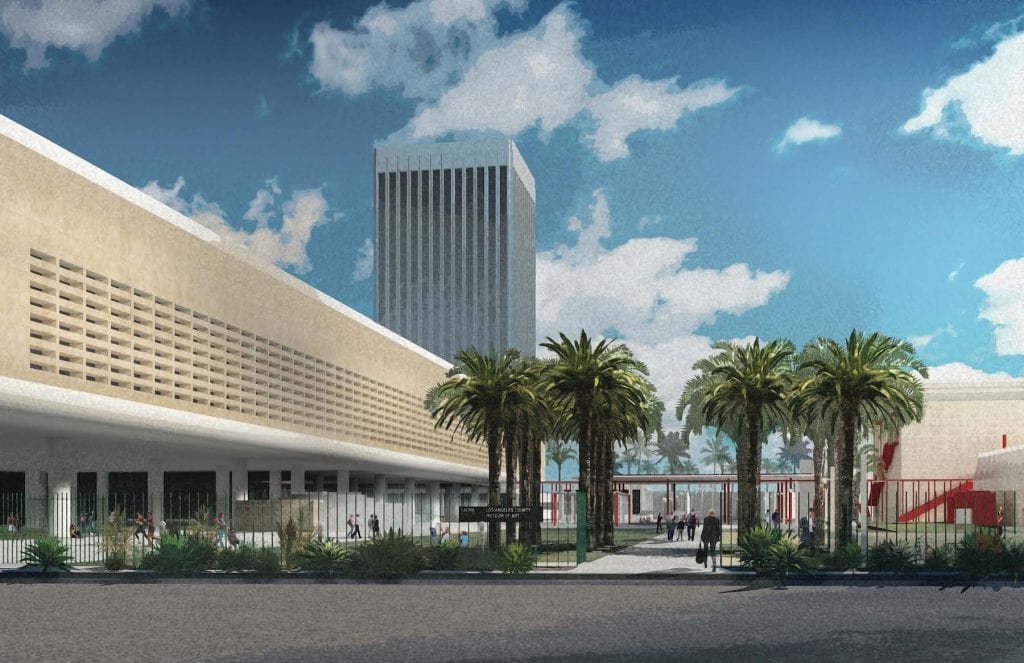
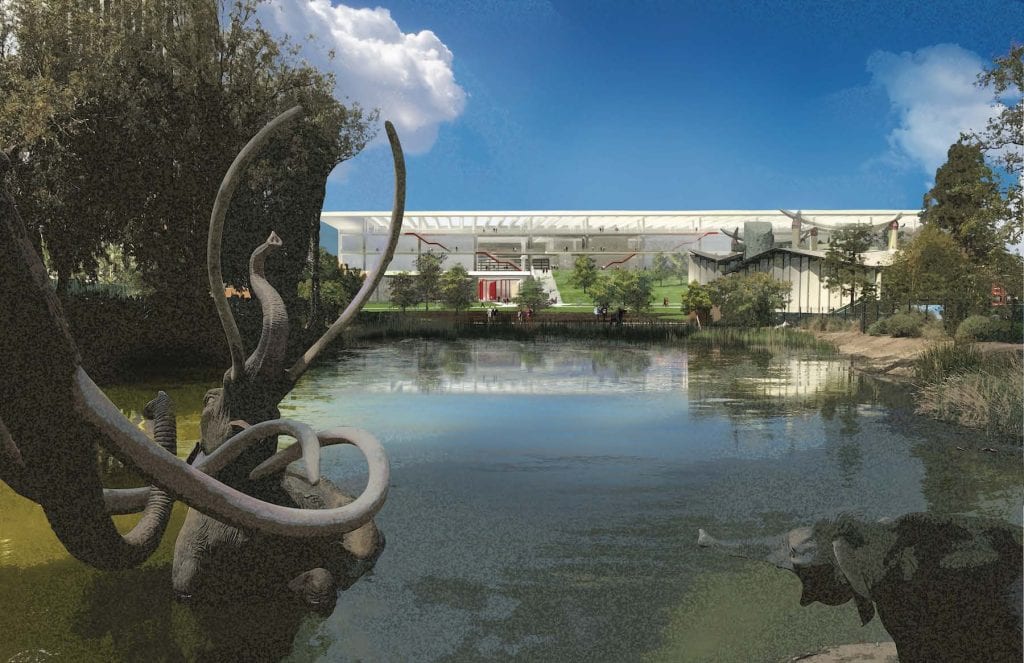
Images © Paul Murdoch Architects
LACMA Wing by Coop Himmelb(l)au, Vienna
Jury comments: Emphasizing “an architecture that combines functionality with aspiration,” Coop Himmelb(l)au designed three main elements: landscape plinth and two, three-level “floating” gallery wings. Public circulation on ramps connecting the volumes would be encased by expressive amorphous forms whose openness to the outside refreshes the museum visiting experience. These public spaces are accessible without a ticket to the museum, but windows into the galleries are meant to entice people inside. The jury appreciated the curatorial flexibility of generous gallery spaces, with 22-foot floor-to-ceiling heights, the possibility of mezzanines and intimate galleries, and open floor plates. “This entry combines issues of great efficiency with moments of drama,” noted the jury. “The ‘bubbles’ offer exciting spaces that celebrate the public realm while connecting to straightforward, practical, functional galleries in the wings.”
Images © Coop Himmelb(l)au
HILLACMA by TheeAe, Hong Kong
Jury Comments: TheeAe (The Evolved Architectural Eclectic) considers Los Angeles’ diversity when proposing the museum as “a new cultural platform that connects people from different walks of life,” by simultaneously offering enclosed cultural spaces and an open, sculpted, outdoor landscape. The tall building (five levels plus garden roof) combines an undulating façade along Wilshire Boulevard to the south with “hill” element sloping into the park on the property’s north side. The jury remarked that the dramatic hybrid design would make it a “destination building” cleverly designed to sustain the urbanity of Wilshire on one side while extending the bucolic nature of the park on the other. “The Wilshire façade becomes a kinetic wall, imparting a strong urban experience that changes as you drive by, which is how most Angelenos experience the city,” noted the jury.” “The back façade, a built hillside, is a landscape event that adds a surprising new participatory dimension to Hancock Park. This will be a hill you want to climb.”
Images © TheeAe
Category: Existing Buildings
Re(in)novating LACMA” by Reiser + Umemoto, New York
Jury comments: Reiser + Umemoto’s aim was “to create a coherent, retroactive masterplan that builds off the campus’ prior successes and seeks to engage and reinvigorate the full breadth of LACMA’s collection.” The three-pronged approach includes adding new elements in and around the original 1965 buildings, binding them into a new whole. The Cone sits within and atop the Ahmanson; The Bar, an elevated gallery building, transects the campus from north to south, offering an appropriately scaled Wilshire entrance and new gallery space; The Cluster replaces the 1986 building with a series of interior pod-shaped galleries, as well as exterior exhibition space on a reimagined plaza level. “The architects found a way to make the plaza into a connective tissue and strategically make the existing buildings work as an ensemble,” said the jury, which also commended the clear circulation that employed new interstitial spaces to move people through the building’s interior spaces.
“Tabula LACMA” by Barkow Leibinger, Berlin with Lillian Montalvo Landscape Design
Jury Comments: This “reconstitution” is an unusual hybrid of old and new, as it maintains the scale and context of the original LACMA buildings by reconstructing them with modern, sustainable materials, then interconnecting them with a new plinth form punctured by courtyards. Barkow Leibinger—working with landscape designer Lillian Montalvo—stresses this would “provide spaces for art, delight, and public encounter.” The jury thought this flexible, spacious design addressed the changing role of museums by including a good amount of shopping, cafés, and event venues that urbanize the spaces and engender a lively environment. “There’s a powerful idea of using the area around the pavilions to create a whole new programmed space,” according to the jurors. They enjoyed the rediscovery of the inner plaza and could “imagine these would be great spaces to be in, as well as fun to discover.”
Images © Barkow Leibinger
“Reimagining/Restructuring” by Saffet Kaya Design, London
Jury comments: Replacing the 1986 building, Kaya Design proposes “to preserve the best elements of the past while creating a more contemporary, multi-use alternative space.” An elevated volume that respects the scale of the existing structures has solid walls on three sides for curatorial flexibility, then opens to the north with an all-glass façade. Circulation into the entrance is through a gentle ramp/walkway leading into the lobby that directs visitors to the other buildings on other floors—the ramps equalizing the importance of all adjacent floors. The new structure is reserved for exhibition space on six above-grade levels, including the interior of the spiral element. “This design achieves a considerable service to the campus, making the east campus more coherent than it’s ever been,” said the jury. “The biological form of the spiral—as ancient as seashells and hurricanes—gives value to the floors it connects.”
Images © Kaya Design






























